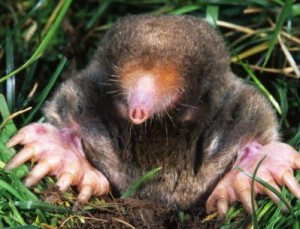

A menace to lawns everywhere, moles can wreak havoc on a property in just a few days. Lawn damage caused by moles plagues homeowners and lawn care specialists alike. Seldom seen as they tirelessly tunnel underground, moles leave their telltale marks above ground as unsightly “mole hills”, mounds of soil, or grassless brown streaks. Think back to the trails you would see Bugs Bunny leave in the cartoons as he would travel underground.
With a life span of about four to six years, moles have bluish-black to gray fur. These yard vandals have a thin snout, needle like teeth, wide paddle type clawed feet with an extra thumb and tiny ears. Typically four to five inches in length, some species can grow up to a foot long. Moles have pointed noses that differentiate them from other lawn and garden pests such as meadow voles, gophers, and shrews. They are of the Talpidae family in the order Soricomorpha and can be found in most parts of North America, Asia, and Europe. As rather efficient diggers, they can tunnel about a foot a minute.
Pushed up soil and runways tracks in the lawn are indicators of the mole’s presence. All moles can be damaging, but the Eastern mole is by far the most widespread, typically referred to as the common or grey mole. Moles are not rodents, but belong to a group of mammals called insectivores. Moles have a very high metabolic rate and, therefore, have to consume large amounts of food in order to thrive.
Moles mate during the months of February and March. They produce a single litter of three to five; gestation period is six weeks. Moles do not hibernate and store food or fat. Severe lawn damage can result until mole control is used or the lawn surfaces freezes in the winter. Newborn female moles will mate the following spring. Since their domain is underground without light, activity occurs both during the day and night. They can be seen during damp days or the day after a rain during the spring and summer months as they push up the tunnels or mounds. If the lawn freezes in the winter or there is a very dry summer, the moles use deep burrows.
Moles have large appetites and may eat up to 100 percent of their body weight in one day. White grubs, earthworms, beetles, and assorted larvae are their principal foods. Moles feed primarily on insects that feed below the ground. The tunnels that the mole excavates while searching for food may be used only once or may be traveled repeatedly. Moles may be active during any time of the day and seem to prefer cool, moist soil (the same as that preferred by grubs and earthworms). Moles do not eat the roots and bulbs of flowers and vegetables, a commonly held belief. Voles and shrews will attack the roots and bulbs. In fact, moles may benefit these plants by feeding on grubs and worms that can damage them. However, the tunneling activities of moles may disfigure lawns and gardens.
If your yard shows any of these signs of damage, give us a call and one of our expert technicians will be happy to set up an appointment with you and develop a treatment plan.
